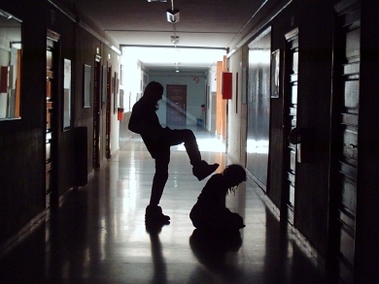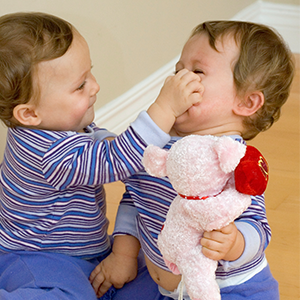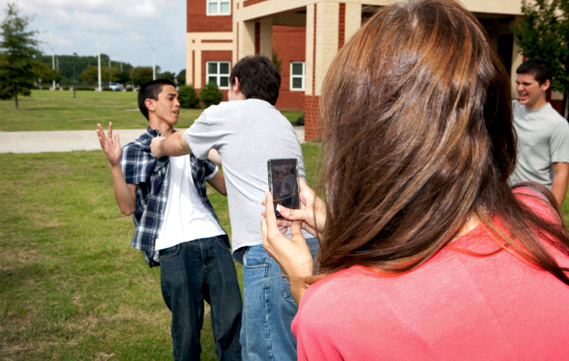
On my first part I talked about the misconception people have about bullies, and before slightly touching the prevention programs against bullying in schools I would like to continue with some important facts about this topic.
Bullies are often seen as someone who repeatedly attacks another individual who is completely defenseless and not fight back. Ross (2002) summarized a study done in Finland; these people during adolescent years are likely to be at risk of depression and low self-esteem. However, is this characteristic preventable in early years? Tremablay & Nagic (2005) stated a co-relation in the behavior and how it is close to impossible to prevent how a bully is born: For children it is normal to act like a bully. Toddlers typically hit or kick their mothers and pinch and bite other toddlers and older children call each other derogatory words otherwise known as name-calling; they often criticize each other’s personal traits and even curse at their friends. As these actions seem to be bullying, no single act defines a bully. Berger (2007) noted that to be bullying, harmful actions are repeated and victims are defenseless.
Bullies are often seen as someone who repeatedly attacks another individual who is completely defenseless and not fight back. Ross (2002) summarized a study done in Finland; these people during adolescent years are likely to be at risk of depression and low self-esteem. However, is this characteristic preventable in early years? Tremablay & Nagic (2005) stated a co-relation in the behavior and how it is close to impossible to prevent how a bully is born: For children it is normal to act like a bully. Toddlers typically hit or kick their mothers and pinch and bite other toddlers and older children call each other derogatory words otherwise known as name-calling; they often criticize each other’s personal traits and even curse at their friends. As these actions seem to be bullying, no single act defines a bully. Berger (2007) noted that to be bullying, harmful actions are repeated and victims are defenseless.
| Contrary to belief, children do not need to observe models of physical aggression to initiate such act. Côté S et al., (2006) conducted a research on the level of aggression on toddlers during preschool years. They found that the development of physical aggression during this period increases during the first 30 to 42 months after birth but slightly decreases over time. Why is it that fewer girls than boys reached the highest frequency levels? And why is it that girls tended to reduce the frequency of their aggression earlier in life? The decline in the frequency of aggression in boys and girls was something unexpected for researchers in social sciences as children, after several years are exposed to examples of sexism, aggression and other kinds of derogatory behavior. |
Although, aggressive young children are rejected, Bukowski & Sippola, (2001) found on a survey made to adolescents that some bullies may be respected, and even liked. The main reason behind was their social status. Rather than being aggressive bullies, they were feared because of the power they hold at school. These bullies had “friends” who encouraged them to do something funny so everyone would laugh.
Broidy et al., (2006) conducted a study up to adolescent period where they found that preschool is the sensitive period to engage methods to regulate physical aggressions. Also, they found that this type of aggression may be the root to other types of bullying. They also found that the minority of elementary school children (5% to 10%) who continue to show high levels of physical aggression remain at greatest risk of engaging in physically violent behavior during adolescence. So how can we spot early behavior of bullying or how can we identify it?
According to a study conducted by Côté S (2006) he mentioned some key factors that could guide us to identify children with this kind of behavior such as women having children with serious physical aggressions problems, low education level, a history of behavior problems, and first delivery at a young age, smoking and/or drinking during pregnancy, and low income. Although, this sadly might be true (as we see on a daily basis) I would argue that this may cause a legitimated sense of discrimination towards some families and even legal problems against the school board.
Broidy et al., (2006) conducted a study up to adolescent period where they found that preschool is the sensitive period to engage methods to regulate physical aggressions. Also, they found that this type of aggression may be the root to other types of bullying. They also found that the minority of elementary school children (5% to 10%) who continue to show high levels of physical aggression remain at greatest risk of engaging in physically violent behavior during adolescence. So how can we spot early behavior of bullying or how can we identify it?
According to a study conducted by Côté S (2006) he mentioned some key factors that could guide us to identify children with this kind of behavior such as women having children with serious physical aggressions problems, low education level, a history of behavior problems, and first delivery at a young age, smoking and/or drinking during pregnancy, and low income. Although, this sadly might be true (as we see on a daily basis) I would argue that this may cause a legitimated sense of discrimination towards some families and even legal problems against the school board.
| Observers/ Bystanders Most children become prosocial: they “cooperate, share materials, invite others to play” (Bierman, 2004). As mentioned before Toddlers are typically aggressive when being in their mother’s womb, therefore they are not rejected from their peers/family for their aggression because these behaviors occur infrequently and selectively. Although bullies may be popular, it is still a fact that most of the best-liked students are either bullies or victims (Rose, Swenson, & Waller, 2004). |
However, observers/bystanders are not neutral (Salmivalli, 2001). In a study done by Latane and Barley (1968) were they surveyed 70 male undergraduates at the Florida State University they found that 75% of the bystanders decide whether an event is an emergency, each bystander looks to the others for guidance before acting. Thus, seeing other bystanders remaining passive causes the others to not take action.
Another example comes from a study done Pepler, Craig, & Roberts (1998) where they studied children in a playground. They found that 85% of bullying involved several children observing what was happening to their peers and decided not to do anything. However, research also confirms the value of friendship and how many people value this as the most important factor to diminish and decrease bullying. One longitudinal study of 208 victims, age 13 – 16, found that 72% were no longer victims two years later (Smith, Talamelli, Cowie, Naylor, & Chauhan, 2004). The main reason was because they were able to find better friends. These friends were not protecting them but it seems that “lone” bullies often decide not to proceed when they see a defenseless person accompanied with others.
Discussion
Could this be a solution to avoid bullying in teenage years? I would argue that not everyone has the opportunity to become part of a group. There are still, sadly, personal traits that would make someone unlikable. Would it work to create a program were teachers are able to identify each students and assign them to become part of a specific group? This would involve creating more extra-curricular activities aiming to satisfy everyone needs.
Prevention at school, disappointing?
Another example comes from a study done Pepler, Craig, & Roberts (1998) where they studied children in a playground. They found that 85% of bullying involved several children observing what was happening to their peers and decided not to do anything. However, research also confirms the value of friendship and how many people value this as the most important factor to diminish and decrease bullying. One longitudinal study of 208 victims, age 13 – 16, found that 72% were no longer victims two years later (Smith, Talamelli, Cowie, Naylor, & Chauhan, 2004). The main reason was because they were able to find better friends. These friends were not protecting them but it seems that “lone” bullies often decide not to proceed when they see a defenseless person accompanied with others.
Discussion
Could this be a solution to avoid bullying in teenage years? I would argue that not everyone has the opportunity to become part of a group. There are still, sadly, personal traits that would make someone unlikable. Would it work to create a program were teachers are able to identify each students and assign them to become part of a specific group? This would involve creating more extra-curricular activities aiming to satisfy everyone needs.
Prevention at school, disappointing?
| Communities and parents believe that it is the responsibility of the school to eliminate and eradicate bullying. However, so far the outcome has been called, disappointing in the United States (Juvonen & Graham, 2004; Limber, Nation, Tracy, Melton, & Vlerx, 2004). One of the possibly reasons may be that many schools seek to replicate the 50% Olweus achieved in his first effort. |
However, many argue that veracity of these findings as changing a behavior is a long, gradual process and the fact that few schools interventions have been scientifically evaluated (Roland, 2000).
Olweus led another experiment in Norway, a “whole school” approach designed to include entire schools, from coordinator who set the curriculum, teachers who were thoroughly trained, to students of all grades who spoke about the necessity to stop bullying and protect defenseless people. This research not only involved 450 schools, but according to their data, it reduced bully-victim problems by 32 - 49 percent. Olweus reported, as many have, that being extensive, precise, and dedicated in every school is crucial. Also, he reported that the older the children are, the more difficult it is to change them.
Olweus’ “success” is not easy to replicate. Especially in the U.S were the number the number of multi-racial communities is on the raise. Moreover, U.S studies finds that immigrant children may be more likely to be bullied (Yu, Huang, & Schwalberg, 2003).Although, one reason that might be the key factor for it’s success, however arguably, is thought to be support from teachers (Smith, Schneider, Smith, & Ananiadou, 2004) and the gradual initiative and willingness from the principal of the school. Thus, some failures have been interpreted as the early signs of success where students become more sensitized by taking surveys about the topic bullying. However, this hypothesis has been criticized as an explanation of failure, especially when projects that do not show sensitization are named as successful research.
Conclusion
I believe, scientists, communities, teachers, parents, and everyone involved in the development of children need to put more effort into the matter. More importantly, accept as a fact that a change in the children’s behavior, where it has been proved that many are born with “aggressive” traits, not to feel disappointed with the negative results. Moreover, scientists and researchers must communicate their findings to their peers or educate the non-scientists/researchers. The government, in many countries, has realized the threat of bullying, but few understand the real complexity of the problem. However, the discovery that bullying is widely spread and harmful has motivated researchers and schools to describe it in details, “predict” (in some cases) and even act against it in order to prevent it.
References
Berger, K. (2007). Update on Bullying at school: Science forgotten?
Bierman, K. (2004). Peer rejection. New York: Guilford Press.
Broidy L, Nagin D, Tremblay R, Brame B, Dodge K, Fergusson D, Horwood J, Loeber R, Laird
R, Lynam D, Moffitt T, Bates J, Pettit G & Vitaro F. (2003).Developmental trajectories of childhood disruptive behaviors and adolescent delinquency: a six-site, cross-national study. Developmental Psychology
Côté S, Vaillancourt T, Leblanc J, Nagin D & Tremblay R. (2006). The development of physical aggression from toddlerhood to pre-adolescence: A nation wide longitudinal study of Canadian children. Journal of Abnormal Child Psychology
Côté S, Vaillancourt T, Barker E, Nagin D & Tremblay R. (2007). The joint development of physical and indirect aggression: Predictors of continuity and change during childhood. Developmental Psychopathology.
Côté S (2007). Sex differences in physical and indirect aggression: A developmental perspective. European Journal of Criminal Policy and Research.
Pepler, D. J., Craig, W. M., & Roberts, W. (1998). Playground observation of aggressive and non-aggressive children. Merrill-Palmer Quarterly.
Roland, E. (2000). Bullying in school: three national innovations in Norwegian schools in 15 years. Aggressive Behavior
Ross, D. (2002). Bullying. In J. Sandoval (Ed.), Handbook of crisis counseling, intervention, and prevention in the schools (electronic version) 2nd ed. (pp. 105-135): Mahwah, NJ: L. Erlbaum Associates.
Russell, D, Clark III & Larry W. (1972). Why don’t bystanders help? Because of ambiguity? Journal of Personality and Social Psychology. Vol 24, No. 3.
Salmivalli, C. (2001). Group view on victimization: Empirical Wndings and their implications. Peer harassment in school: The plight of the vulnerable and victimized NewYork: Guilford Press
Smith, J, Schneider, B, Smith, P, & Ananiadou, K. (2004) The effectiviness of whole school anti-bullying programs: a synthesis of evaluation research. School Psychology Review.
Smith, P. K., Talamelli, L., Cowie, H., Naylor, P., & Chauhan, P. (2004). ProWles of non-victims, escaped victims, continuing victims, and new victims of school bullying. British Journal of Educational Psychology
Tremblay R, Nagin D, Séguin J, Zoccolillo M, Zelazo P, Boivin M, Pérusse D & Japel C. (2004). Physical aggression during early childhood: Trajectories and predictors.
Yu, St. M., Huang, Z. J., & Schwalberg, R. H. (2003). Acculturation and the health and well being of U.S.immigrant adolescents. Journal of Adolescent Health.
Olweus led another experiment in Norway, a “whole school” approach designed to include entire schools, from coordinator who set the curriculum, teachers who were thoroughly trained, to students of all grades who spoke about the necessity to stop bullying and protect defenseless people. This research not only involved 450 schools, but according to their data, it reduced bully-victim problems by 32 - 49 percent. Olweus reported, as many have, that being extensive, precise, and dedicated in every school is crucial. Also, he reported that the older the children are, the more difficult it is to change them.
Olweus’ “success” is not easy to replicate. Especially in the U.S were the number the number of multi-racial communities is on the raise. Moreover, U.S studies finds that immigrant children may be more likely to be bullied (Yu, Huang, & Schwalberg, 2003).Although, one reason that might be the key factor for it’s success, however arguably, is thought to be support from teachers (Smith, Schneider, Smith, & Ananiadou, 2004) and the gradual initiative and willingness from the principal of the school. Thus, some failures have been interpreted as the early signs of success where students become more sensitized by taking surveys about the topic bullying. However, this hypothesis has been criticized as an explanation of failure, especially when projects that do not show sensitization are named as successful research.
Conclusion
I believe, scientists, communities, teachers, parents, and everyone involved in the development of children need to put more effort into the matter. More importantly, accept as a fact that a change in the children’s behavior, where it has been proved that many are born with “aggressive” traits, not to feel disappointed with the negative results. Moreover, scientists and researchers must communicate their findings to their peers or educate the non-scientists/researchers. The government, in many countries, has realized the threat of bullying, but few understand the real complexity of the problem. However, the discovery that bullying is widely spread and harmful has motivated researchers and schools to describe it in details, “predict” (in some cases) and even act against it in order to prevent it.
References
Berger, K. (2007). Update on Bullying at school: Science forgotten?
Bierman, K. (2004). Peer rejection. New York: Guilford Press.
Broidy L, Nagin D, Tremblay R, Brame B, Dodge K, Fergusson D, Horwood J, Loeber R, Laird
R, Lynam D, Moffitt T, Bates J, Pettit G & Vitaro F. (2003).Developmental trajectories of childhood disruptive behaviors and adolescent delinquency: a six-site, cross-national study. Developmental Psychology
Côté S, Vaillancourt T, Leblanc J, Nagin D & Tremblay R. (2006). The development of physical aggression from toddlerhood to pre-adolescence: A nation wide longitudinal study of Canadian children. Journal of Abnormal Child Psychology
Côté S, Vaillancourt T, Barker E, Nagin D & Tremblay R. (2007). The joint development of physical and indirect aggression: Predictors of continuity and change during childhood. Developmental Psychopathology.
Côté S (2007). Sex differences in physical and indirect aggression: A developmental perspective. European Journal of Criminal Policy and Research.
Pepler, D. J., Craig, W. M., & Roberts, W. (1998). Playground observation of aggressive and non-aggressive children. Merrill-Palmer Quarterly.
Roland, E. (2000). Bullying in school: three national innovations in Norwegian schools in 15 years. Aggressive Behavior
Ross, D. (2002). Bullying. In J. Sandoval (Ed.), Handbook of crisis counseling, intervention, and prevention in the schools (electronic version) 2nd ed. (pp. 105-135): Mahwah, NJ: L. Erlbaum Associates.
Russell, D, Clark III & Larry W. (1972). Why don’t bystanders help? Because of ambiguity? Journal of Personality and Social Psychology. Vol 24, No. 3.
Salmivalli, C. (2001). Group view on victimization: Empirical Wndings and their implications. Peer harassment in school: The plight of the vulnerable and victimized NewYork: Guilford Press
Smith, J, Schneider, B, Smith, P, & Ananiadou, K. (2004) The effectiviness of whole school anti-bullying programs: a synthesis of evaluation research. School Psychology Review.
Smith, P. K., Talamelli, L., Cowie, H., Naylor, P., & Chauhan, P. (2004). ProWles of non-victims, escaped victims, continuing victims, and new victims of school bullying. British Journal of Educational Psychology
Tremblay R, Nagin D, Séguin J, Zoccolillo M, Zelazo P, Boivin M, Pérusse D & Japel C. (2004). Physical aggression during early childhood: Trajectories and predictors.
Yu, St. M., Huang, Z. J., & Schwalberg, R. H. (2003). Acculturation and the health and well being of U.S.immigrant adolescents. Journal of Adolescent Health.




 RSS Feed
RSS Feed

